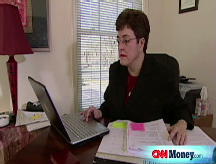Consumer bankruptcies jump in 2008
Study shows that 1.06 million American consumers filed for bankruptcy protection last year.
NEW YORK (CNNMoney.com) -- Bankruptcy filings by American consumers increased nearly a third in 2008, according to a new report.
The American Bankruptcy Institute said overall consumer filings rose to 1.06 million in 2008, compared with 801,840 during 2007. The ABI based its study on data from the National Bankruptcy Research Center.
"Consumers are under great financial stress, with no immediate end in sight," said ABI executive director Samuel Gerdano, in a statement. "We expect the upward spike in personal bankruptcies to continue in 2009."
While the weak economy was a major factor in 2008's increase, the rise in consumer bankruptcy filings is also attributable to better understanding of a key piece of bankruptcy legislation, according to Henry Sommer of the Consumer Bankruptcy Assistance Project in Philadelphia.
The Bankruptcy Abuse Prevention and Consumer Protection Act of 2005 made it harder for individuals to receive Chapter 7 bankruptcy protection, in part by increasing the costs associated with filing.
"There was a perception that the 2005 law prevented bankruptcy, but that perception is going away now," Sommer said.
Chapter 7 is designed to give individual debtors a "fresh financial start" by discharging many of their debts. Under Chapter 7, a filer's assets - minus those exempted by his or her home state - are liquidated and given to the creditors who are first in line for repayment. Any debts that remain are cancelled.
In 2005, total consumer bankruptcy filings jumped 32% as individuals raced to file before the new rules were instituted. Total filings then plummeted 72% in 2006 after the act went into effect.
But bankruptcy filings have increased despite the 2005 act as economic conditions have deteriorated and the nation has been mired in a recession for more than a year, resuming their rise, up 40% in 2007.
Sommer said he expects bankruptcies to continue climbing in 2009 "as the recession kicks in and people start to have problems with their credit cards and other debts."
And given the "foreclosure crisis" currently plaguing the housing market, "people won't be able to fall back on their home equity," Sommer said. ![]()


